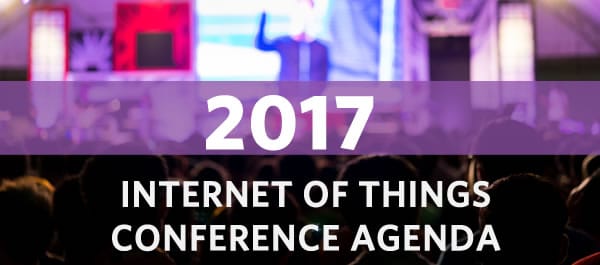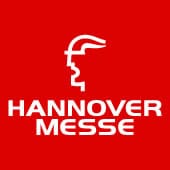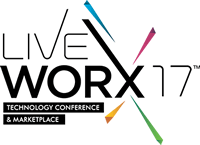An overview of the main Internet of Things (IoT) events, conferences and exhibitions in 2017.
Sometimes it seems that the number and size of Internet of Things conferences, tradeshows and other events is growing as fast as the Internet of Things itself.
It indicates how the market is evolving, and more importantly, how the desire to learn about the benefits of IoT, best practices, examples and ways to set up efficient, secure and scalable IoT deployments in practice, is increasing as Internet of Things spending is poised to grow fast with a larger number and broader variety of industries and use cases, albeit mainly in industrial markets (Industry 4.0 and Industrial Internet of Things) this year.

There are several tradeshows, congresses and conferences where the Internet of Things is omnipresent since several years. Moreover, there are several ‘pure’ IoT conferences, tradeshows and events touching upon specific aspects of – or related with – the Internet of Things and its use cases and IoT examples.
Below is an overview of Internet of Things events, events where IoT evolutions will take center stage and some major vendor and industry body conferences. We’ve added videos and content from previous event overviews and keynotes (where applicable) – so you can get in the mood when building your 2017 Internet of Things conference agenda and learn from previous editions.
IoT conferences and events 2017
Smart City Expo World Congress 2017 (14-16 November, Barcelona)

The edition 2016 of Smart City Expo World Congress was a success with close to 30 percent more attendees than the year before.
While companies such as Cisco, Huawei, Philips, Microsoft and many others showcasing their smart city solutions and over 600 cities represented and in several cases showing their achievements and sharing their lessons, the event’s message moved from technology to people, the human factor and practical applications and implications in the smart city domain.
In 2017, smart city Barcelona hosts the 3-day event from November 14th until November 17th. One to add to your list if you’re even remotely interested in the evolutions and developments regarding smart cities.
IoT Tech Expo North America 2017 (29-30 November)
On November 29th and 30th, the Santa Clara Convention Center hosts the second edition of IoT Tech Expo North America.
The US event is part of a series of IoT Tech Expo events: a Europe edition, IoT Tech Expo Global and this IoT Tech Expo North America.

Just as its other editions, IoT Tech Expo North America 2017 is co-hosted with a conference on blockchain and one on AI by the same organizer in the same venue. The 2017 edition of IoT Tech Expo North America comes with two free and four paying tracks, covering the main IoT evolutions in areas such as IoT development, IoT innovations, Industry 4.0, smart transportation, smart cities, IoT data, IoT security and more.
Internet of Things World events (various locations: US, Europe)

The IoT events organized by Informa PLC might not be the cheapest but they are very focused on actual applications and are really leading in many regards.
In 2016 there was an Internet of Things World in the US and an Internet of Things World Europe. On top of that, Informa PLC also organizes other IoT-specific events so you might want to check them all out (Smart Home Summit, Smart Cities Summit, IoT Security Summit, the list is long).
IEEE World Forum on Internet of Things (US)
As far as we know the IEEE World Forum on Internet of Things is traditionally the last major IoT event of the year.

The agenda of the event in 2016 (12- 14 December) with a keynote by Vint Cerf but most of all a range of in-depth sessions makes it the annual place to be for the industry, primarily in an Industrial Internet of Things context. How else could it be as the event is organized by the IEEE, the largest technical professional organization dedicated to advance technology for the benefit of humanity, among others known for its several IEEE Standards?
Past IoT conferences and events 2017
Consumer Electronics Show 2017 in Las Vegas (USA)
The Consumer Electronics Show (CES) is not an IoT-specific tradeshow but the annual gathering of the consumer electronics market again showed several products, solutions and evolutions in the Consumer IoT segment – and beyond.

The Consumer Internet of Things has been taking center stage at the event for several years now and although there were quite some interesting innovations, sessions and keynotes, as per usual there were also some rather pointless products on the tradefloor.
Below is an overview in the form of videos from CES 2017. Topics include: the, from an IoT perspective, much talked about mobile 5G standard (a panel discussion and a keynote by Qualcomm), CESTV videos (short impressions) regarding the connected world (mainly connected consumer devices and smart home), robots and robotics, accessibility, drones and smart/connected vehicles and roadways. There is also a Nissan keynote on the future of vehicle technology. The next US edition of CES takes place on January 9-12, 2018.
IoT Evolution Expo 2017 in Fort Lauderdale (Florida, US)

IoT Evolution Expo West took place from February 7th until February 10th 2017 (there is an edition in July in Las Vegas). IoT Evolution Expo is one of the oldest and most successful Internet of Things conferences in the world.
Even if it’s been in the run for quite some time it’s an important annual gathering for the industry and for businesses that want to discover state-of-the-art solutions and Internet of Things applications and use cases.
Industry of Things World USA, San Diego (USA)
On February 20th and 21st, 2017, the Industry of Things World USA conference took place.

The event, which is mainly about the Industrial Internet of Things and Industrial Internet was organized in San Diego’s Hard Rock Hotel and featured speakers such as Dean Bartles (President, North American Manufacturing Research Institute, UI Labs), Gary Hayslip (CISO, City of San Diego), Jennifer McNelly (Senior VP, The Manufacturing Institute) and Chris Dennis (Global Product Strategy, Coca Cola) to (really) name just a few.
Mobile World Congress 2017 in Barcelona (Spain)
Although MWC is a non-IoT-specific congress, there were plenty of good reasons to attend the 2017 edition.

If you know the evolutions and even battles in the mobile IoT connectivity space and think about the next stages in mobility, you know what was hot at Mobile World Congress 2017 from an IoT perspective. From 5G to the role of operators in smart cities.
IoT Asia 2017 in Singapore (March 29-30)

IoT Asia is a leading exhibition and conference on the Internet of Things for the APAC region.
IoT Asia 2017 took place on March 29th and 30th, 2017. Asia Pacific is a key Internet of Things market for years to come as IoT spending patterns show,
Hannover Messe: Industrie 4.0 and Industrial Internet of Things (March 24 -28 April)
Hannover Messe is the world’s leading industrial fair. In 2017 the event took place from 24 -28 April.

Since several years now Industrie 4.0 and the Industrial Internet of Things are taking center stage at the event. Just like that other well-known trade fair in Hannover, CeBIT (more below), Hannover Messe is organized by Deutsche Messe (in fact, CeBIT is a spin-off of Hannover Messe).
In 2017 the theme was integrated industry. Hannover Messe 2017 was larger than its previous edition where former President Barack Obama was present (the US manufacturing industry is well represented at the event this year again), due to the combination with logistics industry fair CeMAT.
Smart Cities Week Silicon Valley (May 8-10, Santa Clara, US)
If you want to know what the next-generation smart cities look like and learn best practices from city leaders you might want to attend Smart Cities Week Silicon Valley.

The conference takes place in the Santa Clara Convention Center. Among the speakers are Jason Anderson of Cleantech San Diego, Cisco’s Bas Boorsma (Director Internet of Things & City Digitization, North Europe), Charles J. Brennan (CIO of the city of Philadelphia) and Los Angeles Chief Data Officer Lilian Coral.
On the agenda: a smart cities readiness workshop, a workshop around utilities advancing cities, plenary sessions with the mentioned and other speakers and, last but not least, a range of fireside chats and breakout sessions on various aspects of future smart cities and smart city action plans.
Smart Cities Week Silicon Valley is organized by Smart Cities Council. City leaders already could join Smart Cities Week conferences in Washington D.C. With the Silicon Valley conference, the Smart Cities Council expands to the West Coast.
LiveWorx 2017 in Boston (US): May 22-24
From May 22nd until May 24th, Boston welcomed the edition 2017 of LiveWorx.
LiveWorx is a global technology conference and marketplace for solutions engineered for a smart, connected world.
IoT Tech Expo Europe 2017 (1-2 June)
On June 1st and 2nd Berlin (Germany) hosted the IoT Tech Expo Europe 2017. The event was organized for the second time and has an impressive list of speakers and broad range of covered topics and industries.

There is also an IoT Tech Expo North America (in 2017, taking place on November 19-20) and an IoT Tech Expo Global. Topics at the Europe edition in Berlin included connected industry, smart transportation and cities, developing for the IoT and more.
Among the speakers: Alun Jones, Data Scientist at Konecranes, Derek Myers, Group Director Channel Strategy & Development at Coca-Cola, Netslé’s Ralf Hagen, Microsoft’s Peter Hoffmeister and Kai Gait, Senior Global Director at GSK (health technology), to mention a few from a long list. The event was co-hosted with Blockchain Expo Europe 2017 and AI Expo Europe 2017.
IIoT and Digital Solutions in Oil & Gas (Amsterdam, 07 – 08 June)
On June 7 and 8, Amsterdam (The Netherlands) hosted the first edition of IIoT and Digital Solutions in Oil & Gas.
The oil and gas industry is among the main industries from the perspective of the Industrial Internet of Things and intensively uses digital technologies and communication technologies, which are in some cases very specific for the industry, among others regarding connectivity.
The event, revolving around the digital transformation of oil and gas, had speakers and participants from companies such as Shell, Statoil, Air Liquide, MOL, Gazprom Neft, ENI, Accenture, McKinsey, Maersk Drilling and more.
The theme of the event: “Optimize operational efficiency through digitalization”, with a clear role for IIoT.
IoT Week 2017 in Geneva (Switzerland): June 6-9
The IoT week is organized by the IoT Forum since 2011. Previously held in Barcelona, Berlin, Venice, Bled, Helsinki, London, Lisbon and Belgrade, the edition 2017 took place in Geneva (Switzerland) from June 6th until June 9th.

Organizer IoT Forum (Internet of Things International Forum) is an independent organization based upon membership with the goal, on top of organizing IoT Week and developing other actvities among members, to promote international dialogue and cooperation on the Internet of Things.
IoT Week 2017 was organized over 4 days, including a pre-conference day. The speakers at the event came from across the globe and are experts in the Industrial Internet of Things. Topics in 2017 included IoT Emerging Technology, IoT and Sustainable Development, IoT Privacy & Security, and IoT Market and Finance. In 2017 a new conference by the IEEE Subcommittee on the Internet of Things was collocated with the IoT week. Geneva, Switzerland: 6th to 9th June 2017.
Sensors Expo and Conference, San Jose (US): June 27-29

The 2017 edition of the Sensors Expo & Conference took place from June 27th until June 29th in the McEnery Convention Center in San Jose, California.
It is not the only event for people who are active or interested in the rapidly booming market for smart sensors but it is the leading one in the US (maybe even worldwide) and in 2017 it already celebrated its…32nd edition!
IoT Solutions World Congress 2017 Barcelona (Spain): 3-5 October
Looking at the success of the previous editions and the industry and visitor support for the IoT Solutions World Congress 2016, IoT Solutions World Congress 2017 was the place to go.
This event, which is part of the Barcelona Industry Week, has grown enormously in no time and is an excellent barometer and source of information, inspiration, collaboration and transformation. Despite transportation delays on the first day due to a general strike, the event offered plenty of all that and more.
Check out our IoT Solutions World Congress Barcelona 2017 page for curated content from the event, takeaways from the presentations and keynotes and several launches and innovations such as the launch of Intel SDO (Secure Device Onboard), enabling very fast, secure and large scale IoT device onboarding. At the edition 2017 there was also a lot of attention for blockchain with separate tracks and a lot of attention for the convergence of blockchain and IoT.
Barcelona Industry Week 2017 (1-6 October)
From October 1st until October 6th Barcelona aims to be the capital of the 4th industrial revolutions as the organizers of Industry Week 2017 put it.

Barcelona Industry Week is not really an event but a series of events which happen in the same venue, have an industrial focus and cover various topics. In 2014 the IoT Solutions World Congress became one of these events and as you can see on our IoT Solutions World Congress 2017 page, the edition 2017 promises to be a record-breaking one. In total there are 8 events at Barcelona Industry Week. If you’re interested in Industry 4.0 it’s certainly a place to be. In 2016 a new event on advanced and additive manufacturing was added, for instance: “IN(3D)USTRY From Needs to Solutions”. IN(3D)USTRY takes place again in 2017 too. Attention: watch the dates of the several events. IoT Solutions World Congress for instance doesn’t last as long as Industry Week.
More IoT events and conference for 2017
These are certainly not the only IoT events and conferences. Not even mentioning purely local events there are far more places you can look for an IoT event that suits your needs.
Industry tradeshows
Typical examples of tradeshows and congresses where the Internet of Things is more and more present include:
- Germany-based CeBIT where digital transformation and within that scope Industrial Internet of Things applications are highly present.
- GITEX Technology Week in Dubai, which in 2016 again was (again) abuzz of anything smart. The smart city theme, for instance, has been dominating the leading MEAF event for years now.
When looking at the agendas of some of these more general congresses and tradeshows we can already tell you that the Internet of Things in all shapes and forms will be even more present at all of them in 2017 again.
So, make sure you don’t overlook them when preparing your agenda!
Vendor events
Keep in mind that several vendors have their events.

Sometimes they have IoT-specific sessions in a broader perspective (IBM, for instance) and sometimes they have their own IoT-specific events such as Cisco, which has been hosting an own Internet of Things World Forum since 2013 in various cities across the world (the 2016 edition was postponed until 2017). Also companies like Microsoft, SAP, Intel and many many more are active.
Consultancies and analysts
Then there is a wide ranges of IoT-related conferences which are organized by consultancy firms and IoT is of course also covered in the many conferences organized by research firms such as IDC and Gartner.
They all have event sections on their websites to find an event near you.
Associations and vertical events
Next, there are several associations and alliances of companies who are active in the Internet of Things and also organize events or in some cases member meetings.

There is also a bunch of events for smart homes, smart mobility and vertical applications of the Industrial internet of Things, such as IoT in Oil and Gas, part of the Energy Conference Network, IoT Autonomous Fleet in Canada or the IoT Networks Event. The organizer of IoT Autonomous Fleet by the way organizes numerous IoT events.
More

And of course there are events which are more country-specific, although some also have an international dimension with good agendas such as IoT Planet, organized in French Grenoble in 2016.
We’ll add some events now and then but we’re sure that you have ample choice here to select your next Internet of Things conference, depending on who you are and what you’re interested in!
Top image: Shutterstock – Copyright: red mango – All other images are the property of their respective mentioned owners.




